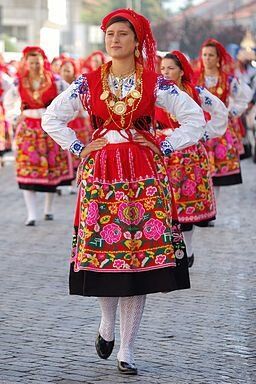Portuguese traditional attire is characterized by its vibrant colors, intricate embroidery, and regional variations.

Women's Attire:
Sáia: A long, full skirt, often with colorful patterns and embroidery.
Camisa: A loose-fitting blouse, often with embroidered collars and cuffs.
Lenço: A colorful headscarf, often tied in a variety of ways.
Xale: A shawl or wrap, often used to keep warm or add a touch of elegance.
Men's Attire:
Camisa: A shirt, similar to the women's camisa, but often with a more masculine style.
Calças: Trousers, often made of wool or linen.
Colete: A vest, often embroidered and decorated with buttons.
Capa: A cloak or cape, often worn during colder months.
Barrete: A traditional hat, often made of felt or straw.
Regional Variations:
Minho: Known for its colorful and intricate embroidery, particularly on the aprons and headwear.
Beira: Characterized by simpler, more functional clothing, often made from wool and linen.
Alentejo: Known for its traditional costumes, often featuring dark colors and simple designs.
Madeira: Influenced by Portuguese maritime history, Madeiran traditional clothing often features elements of sailor attire.
Modern Interpretations:
Today, traditional Portuguese attire is often seen in festivals, cultural events, and folk dances. Modern designers often incorporate traditional elements into contemporary fashion, creating a unique blend of old and new.